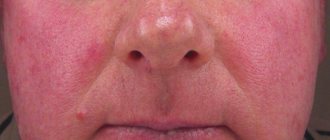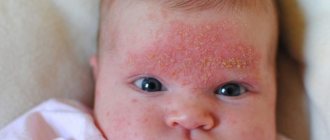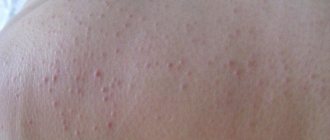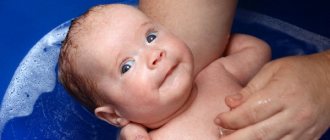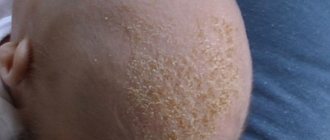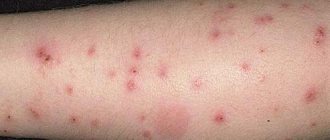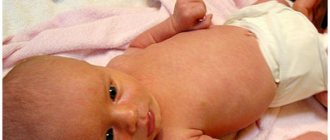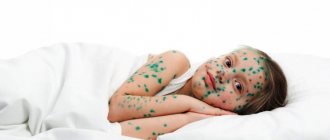Newborns are at particular risk of an allergic reaction. The body of children in this age category is characterized by increased sensitivity. The immune system is fully formed by the age of three years of a child’s life.
In the first months, the immune system may mistakenly mistake many substances from food, baby care products and medicines for dangerous components. Allergies in newborns have characteristic symptoms and require a specific course of treatment.
The most common allergic diseases
- Atopic dermatitis has the main symptom of itching. Appears on the face of a newborn and in flexion areas, the skin becomes dry and has a lot of scratching. Exacerbations often recur; it can be caused by a hereditary factor.
- Urticaria - itchy rashes appear like swollen papules of a reddish color; when you press on them, they disappear. The rash looks like contact with nettles. The causes of the disease can be the use of certain medications, insect bites and food products: nuts, fruits, eggs and seafood.
- Angioedema - a rash similar to urticaria, but the edema occupies large areas of the skin and penetrates into the subcutaneous layers. Swelling can be located anywhere: on the limbs, face or in the intestines. Swelling of the larynx is also more dangerous if it is located on the tongue.
- Bronchial asthma is accompanied by coughing, frequent shortness of breath and asthma attacks, most often during sleep or upon awakening. Asthma begins to progress after repeated bronchitis.
Lifestyle of a child with allergies
If your baby has periodic manifestations of allergies, you need to remember a few simple rules:
- minimize the amount of “at-risk” foods in the diet of a nursing mother and child;
- do wet cleaning in the house more often;
- use special air purifiers;
- remove potential allergens from the home where the baby lives: plants with pollen, animals, feather pillows, etc.;
- carefully choose clothes for your baby: they should be made of natural, non-allergenic materials;
- use only hypoallergenic household chemicals;
- regularly treat the apartment to get rid of fungus and mold;
- bathe the child several times a week in a decoction of string or chamomile;
- get rid of so-called “dust collectors” as much as possible: carpets, soft toys, old massive blankets, etc.
Causes of allergies in infants
- Antibiotic therapy. When a child gets sick, he is prescribed antibiotic treatment. Taking these medications, his intestinal microflora is disrupted and the baby easily perceives various allergens.
- Feeding not according to the clock. If a mother puts her baby to her breast later or earlier than the prescribed time, then the sterility of the intestines is disrupted. This will lead to a failure in the formation of microflora.
- Bad genotype . A child may be hypersensitive, having a hereditary predisposition to allergies. Children's reactions are repeated and they react to the same stimuli to which their parents react. The nature of the allergy is also inherited.
- Vaccinations. Drugs used for vaccinations can become a powerful allergen in a newborn.
- Violation of the diet by a nursing mother . If a mother uses allergenic foods in her diet, then it will end up in the infant’s body and he will have a reaction.
- Method of nutrition. During complementary feeding, the baby is given baby food. And in baby food, the main ingredient is cow's milk, a protein that is found in milk and is a powerful allergen.
It is important to identify the main allergen that causes the baby’s reaction as quickly as possible. By eliminating an allergenic product from your baby’s diet in a timely manner, you will prevent unpleasant consequences and prevent your child’s health from deteriorating.
There are cases when infants are allergic to herbs or herbal bathing mixtures , perfumes, children's cosmetics and household chemicals.
Features of treatment
When the first signs of a possible allergic reaction occur, you need to act. Ignoring the problem that appears will lead to unnecessary consequences.
- The initial task is to identify the allergen .
Understanding which factor leads to unnecessary reactions becomes truly important. - Mandatory contact with a pediatrician. The doctor will conduct an examination and provide effective recommendations.
- Symptomatic therapy to alleviate health conditions. Creams and ointments are often used to relieve itching and pain. In addition, it is allowed to take antihistamines (for example, Fenistil, Zyrtec), enterosorbents, and nasal drops. Treatment is selected taking into account the characteristics of allergic reactions.
- Proper skin care becomes imperative.
Only if you follow the basic rules of facial skin care can you mitigate the initial signs of an allergic reaction, and then supplement the prevention of recurrent illness.
Treatment must be strictly determined by the doctor. Local remedies often relieve only external symptoms, but without such medications, prescribed in accordance with the patient’s age and complaints, it will not be possible to achieve positive changes.
The ointment, which is distinguished by its high fat content, includes more active ingredients, therefore it is used only to treat the source of inflammation. The cream, which has a light texture, is applied to large areas.
Doctors prescribe only non-hormonal and gentle medications. The healing effect will appear more slowly than in other options, but effectiveness is guaranteed.
Experienced doctors traditionally prescribe the following ointments and creams:
- Advantan.
- Fluorocort.
- Ecolom.
- Skin cap.
- Fenistil-gel.
- Psilo-balm.
The more active a product is on the body, the less often it should be consumed.
The choice of medication should be specifically entrusted to the doctor.
Facial allergies in children traditionally appear before the age of 5 years. A similar illness often goes away after the baby’s immune system is strengthened.
In a newborn, an allergy on the face may be a manifestation of the body’s response to external irritants. This phenomenon is observed in every 5th baby in the first months after birth.
Prerequisites for allergic reactions in infants
Rashes that appear on the cheeks and head of babies are most often of allergic origin.
This represents an external problem, indicating that there is a disorder in the baby’s body. The rash on the face itches and itches, causing the baby to sleep restlessly. Even worse, an allergic reaction in an advanced form causes difficulties in the functioning of the baby’s immune system. Persistent colic and regurgitation may appear not only after eating. The feces become green in color with a typical odor. Vomiting occurs from time to time. In case of swelling of the mucous membrane of the respiratory tract, the baby’s allergy is expressed by signs of a cold: runny nose, cough.
In the case of the most unsafe outcome of an allergy, a spasm of the large bronchi may occur. Therefore, it is of great importance to find the allergen without wasting time.
Allergies in the form of rashes on the face of a baby can appear due to a variety of irritating reasons. It can be:
- weather conditions (wind, cold, bright sun);
- dust mites;
- diet of nursing mother and child;
- medicines;
- vaccinations;
- synthetic;
- natural wool;
- mold fungi;
- household chemical products;
- plant pollen;
- insect bites;
- other.
Infants are more susceptible to the risk of allergies:
- with a hereditary predisposition to them;
- premature or low birth weight babies;
- with diseases in the digestive system;
- those on artificial feeding;
- those who are breastfed, whose mothers violate the diet;
- with immunodeficiency.
Difficult labor, fetal hypoxia, and complicated viral diseases also increase the risk of allergies in a newborn.
Return to contents
Types of allergies in a newborn
Allergies in newborns can be of the most common types.
- Urticaria, in which there are numerous small blisters on the face, causing itching and causing discomfort to the baby.
- An allergic rash on the face can be in the form of eczema: the skin is covered with reddish, rough, weeping spots.
In addition to the face, eczema can affect other areas of the body. - Less commonly, infants develop diathesis or atopic dermatitis. This could be a reaction to a food product or another allergen. With diathesis, the skin becomes dry, red, flaky and itchy.
- A rash with a huge number of papules that unite into solid reddish spots is neurodermatitis.
It happens that some infants show signs of an imaginary allergy. This is the so-called three-week rash or milia in a newborn. The essence of this dermatological phenomenon is that at the moment when the mother’s hormones have left the baby’s body, and its own hormonal environment is just beginning to be created, a rash appears in the form of red pimples.
It appears on the face, neck, back and chest and never appears on the tummy, legs and arms. The rashes disappear when the period of adaptation to environmental changes ends.
Return to contents
Prevention and treatment of allergies in a newborn
To prescribe the correct treatment for an allergic rash, first of all, you need to find out the cause of its appearance. Only then will it be possible to eliminate the allergen that attacks the baby’s immature immune system.
You shouldn’t try to cure allergies without the help of others, much less decide which medication to take for your baby.
Selecting the correct treatment and prescribing an antihistamine product for an infant is only within the competence of a pediatrician.
The doctor describes the dose of the remedy and the duration of treatment, prescribes medications for external use in the form of ointments and gels, as well as medications to normalize the microflora in the intestines.
In case of severe allergy symptoms, immediate transportation of the baby to the clinic is required; intravenous drips with hormonal products may be prescribed to localize the signs of allergy (bronchospasm, Quincke's edema).
The room where the newborn lives must be carefully cleaned.
It is recommended to ventilate the room more often.
A breastfeeding woman needs to eat according to the rules: immediately upon the birth of her baby, remove from her diet foods that can cause allergic reactions, and introduce them into her menu slowly and in small quantities.
Only special phosphate-free detergents containing o. are suitable for washing children's clothes. Bedding for babies should be filled with synthetic filler, not wool or down.
Some indoor plants are strong allergens, so it is better not to keep flowers in the room where the child sleeps and is awake.
In addition, plants themselves are dust collectors if they are not carefully looked after. Household dust settling on the trunk and leaves can cause allergies in infants.
By the age of 5–6 years, as a result of the formation of immunity and the baby’s gastrointestinal tract, allergies traditionally cease. In 2% of children, allergies remain forever.
Rate this article:
Allergies in newborn babies are now quite common.
What it is? In essence, this is the reaction of the baby’s immune system to a particular allergen.
Often a baby is allergic to certain foods.
Food allergies in infants, causes
The digestive and immune systems of the baby have not yet formed; their development continues until the age of five. Therefore, when the “wrong” foods enter the esophagus, the child’s body can malfunction. Symptoms begin to appear when the baby comes into contact with the allergen for the second time; when it first enters the body, he only remembers it. The more often a child comes into contact with an allergen, the stronger the signs of allergy will be expressed. The main signs of food allergies in infants:
- Rashes begin on the milk formula;
- If the introduction of complementary foods was early or incorrect;
- If a nursing mother does not follow a diet.
Diagnostics
Skin tests are considered the most effective way to identify an allergen, but such tests can only be performed on children over three months of age. In newborn babies, the factor that provoked a negative reaction of the immune system is determined by a blood test and comparison of its result with the existing symptoms.
An allergy will be indicated by an increased level of eosinophils and immunoglobulin E. Additionally, parents are examined to exclude or confirm the risk of a hereditary predisposition to the disease.
How does an allergy manifest in a baby?
The baby's body is covered with a rash, it also appears on the face. The rash on the skin has a varied color and structure: it begins with small pale pink nodules and ends with bright red spots. It is accompanied by other symptoms:
- The baby develops itching;
- An allergic runny nose begins;
- Digestive upset appears: bloating, diarrhea, increased gas formation, intestinal colic.
Body temperature does not increase. With a non-food allergy, the rash does not appear all over the body, but only where there was contact with the allergen. A rash from a food allergen can appear within seconds or hours. The allergic reaction disappears after a few days unless there is repeated contact with the allergen.
Symptoms
The symptoms of allergies in newborns depend on the type of disease. Signs of an allergic reaction may be accompanied only by skin rashes or supplemented by abnormalities in the gastrointestinal tract, respiratory system, and other vital systems of the body.
The most common factors indicating the development of allergies are skin rashes, irritation of the mucous membranes and digestive disorders.
Allergies in newborns can manifest themselves as the following symptoms:
- redness of certain areas of the skin on the face (most often on the cheeks);
- rashes on the body (folds, buttocks, skin folds, etc.);
- small reddish spots on the skin (accompanied by itching);
- increased drooling and watery eyes;
- nasal discharge (rhinitis symptoms);
- frequent regurgitation (regardless of feeding);
- loose stools with a greenish tint;
- constipation with symptoms of flatulence;
- excessive irritability and tearfulness;
- frequent sneezing and nasal congestion;
- intestinal colic of varying intensity;
- restless sleep and frequent crying at night;
- difficulty breathing and cough of varying intensity.
Differences between flowering and allergies
Flowering and allergies differ not only in external symptoms, but also in location.
In the first case, the newborn's skin may acquire a yellowish or reddish tint, and the rash appears as blisters filled with liquid. The main location of this disease is the face area. Allergies can occur on any part of the baby’s body. Unlike flowering, an allergic rash causes discomfort to the small patient in the form of itching and burning.
Facial allergy in infants
An allergy can appear on the face of a newborn for various reasons; it can be caused by internal and external causes . Internal reasons:
- Breast milk;
- Products included in complementary foods;
- Infant formula;
- Food;
- Medications.
External reasons:
- Hygiene items and perfumes;
- Vaccines and serums;
- Flowering plants;
- Dust, etc.
When breastfeeding, food allergies will not develop if the mother eats properly, then the nutrition for the baby will also be correct. If the mother eats rationally in the first six months, the child will receive all the substances the body needs.
Allergies to drugs and vaccines
Photo: Allergy on the face of a baby - a possible reaction to medications (can be increased)
Prescribing medications to children under one year of age is a complex topic. On the one hand, for children there are specially developed forms and types of medications containing gentle doses of active substances and more aggressively processed auxiliary components, with convenient forms of administration to the body. However, infants often experience an allergic reaction even to them.
One of the drugs that often causes an inadequate immune response is Espumisan Baby. An allergy to Espumisan may be due to its incorrect use, dosage violation, or the individual characteristics of the child’s body. In the instructions for use, allergic reactions are indicated in the “Side Effects” column, which indicates that they occur quite frequently among patients.
For infants at risk for allergies, pediatricians advise replacing this drug with analogues, for example, Bebinos suspension.
What does a drug-induced allergy on the face of infants look like, and how does it manifest itself in addition to skin pathology? Symptoms may be different for each child. The most common symptoms:
- rash similar to food allergies
- skin redness,
- itching,
- peeling,
- tearfulness.
Severe cases are accompanied by intestinal disorders, vomiting, fever, Quincke's edema, and anaphylactic shock.
By and large, a severe allergy can be caused by absolutely any drug; it is impossible to predict. The main thing is not to prescribe medications to your child on your own, without consulting a pediatrician, and not to deviate one step from the instructions for use and doctor’s prescriptions.
Allergies and vaccinations
Separately, it is necessary to note the fear of parents about the development of an allergic reaction to vaccines and serums. Of course, such a possibility exists.
A high risk of developing allergies, even for children at risk, is not an absolute contraindication to vaccination.
Of course, it is carried out under closer medical supervision, precautions are taken, doctors may suggest that the mother spend several days in the hospital with the child so that emergency measures can be taken to relieve the allergic reaction and prevent dangerous complications.
It is worth noting that for some diseases there are vaccines with a reduced antigen load. Ultimately, you should always remember: the infections against which vaccinations are included in the National Vaccination Calendar are much more dangerous than a three- to four-day rash on the skin.
Those types of facial allergies in infants that are associated with medications or vaccines are the most serious, and the child must be examined by an allergist-immunologist.
Artificial feeding and allergies
If necessary, the transition to mixed or artificial feeding must be done carefully and competently , because with this method of feeding the baby can easily experience allergic reactions. Allergic rashes on the face and head can appear from drinking cow's milk, or more precisely, protein (casein). It is the basis for the production of non-adapted infant formula.
Breast milk contains less protein than cow's milk. The child has not fully developed metabolic processes and the urinary system, and breast milk is nutritious and easily digestible. Eating casein may cause the following symptoms :
- A red rash appears on the face and head;
- The child has frequent belching, excessive regurgitation, and sometimes vomiting;
- Unshaped chair;
- Abdominal pain, anxiety;
- Your temperature may rise.
Diagnostic methods
In order to correctly determine the type of allergic reaction, it is necessary to undergo a comprehensive examination, which includes the following procedures:
- Visually examine the child by a doctor and talk with the parents.
- Conducting skin tests, which allow the method of test analysis of possible allergens to identify the cause of discomfort in a child.
- Donating blood to check for antibodies.
- Immunological tests
Let's celebrate! Diagnostic methods are prescribed depending on the intensity of the disease, and can be supplemented if necessary. Timely diagnosis allows you to quickly eliminate unpleasant symptoms and prevent further spread of the body’s reaction.
How to treat allergies in infants
A specialist, an allergist and immunologist, will help you figure out what medications a newborn needs to take. At the initial stage of the disease, you need to consider the nutrition of the nursing mother and select an individual diet for her. The diet should not include foods containing allergens. List of such products:
- Freshwater fish, all types;
- Seafood, including caviar;
- Pet milk;
- Bird eggs;
- Yellow and red vegetables and fruits;
- Cereals, mushrooms;
- Nuts, honey;
- Cocoa, chocolate, coffee.
After the doctor creates a diet, review all hygiene products that you use to care for your child and household chemicals. Replace all this with other products, try to choose non-allergenic ones.
Types of allergies and causes of their occurrence in newborns
Allergies in infants can be divided into 3 types:
- food, which appears in response to allergens coming from food, breast milk, formula;
- medicinal, which appears due to various drugs entering the baby’s mouth and rectum with mother’s milk, as well as due to vaccinations;
- contact, which occurs in response to a variety of external stimuli: creams, shampoos, animals, various fabrics, plants, etc.
There are several reasons why a baby may have allergic reactions:
- Heredity. This reason is the most common. So, if both parents are allergic, then the probability that the child will also be exposed to various allergens is 70%, if one of the parents is 40%.
- Incorrect diet for a nursing mother. Certain components of products, entering the baby’s intestines, lead to the appearance of non-standard, allergic reactions in his body. Of course, it is impossible to predict which product a child may be allergic to, however, first of all, foods from the “risk group” should be excluded from the diet: ketchup, mayonnaise, canned food, red vegetables, fruits and berries, sausages, chocolate, coffee, citrus fruits, etc.
- Intrauterine development. Starting from the 25th week of pregnancy, the baby, while in the womb, is already exposed to various allergens that reach it through the placenta and amniotic fluid. That is why the expectant mother should follow a diet during pregnancy, avoiding “aggressive” foods, give up bad habits, protect herself from various infectious diseases and take medications with caution.
- Some infant diseases. For example, a violation of the microflora in a child caused by viral intestinal infections can also lead to the development of allergies.
Allergies in infants - how to treat?
Medications:
“Diazalin”, “Diprazin”, “Claritin”, “Suprastin” - are prescribed for swelling when bronchospasm begins. For a newborn, it is better to purchase these drugs in syrup. If you experience choking and redness of the face, call an ambulance.
Allergic dermatitis in infants is treated with medications prescribed by the doctor. In order to reduce itching and eliminate the consequences of diathesis, antihistamines are used, and in severe cases, glucocorticosteroids, but only under the supervision of a doctor.
To treat the rash, it is recommended to use ointments and creams: “Vundehil”, “Gistan”, “Desitin”, “Skin-Cap”, “Protopic”, “Fenistil”. Ointments and creams are good at restoring the baby's skin from the effects of allergies: “Bepanten”, “Bepanten plus”, “De-Panthenol”.
When treating allergies in a newborn, it is good to use the aid “Smecta” . It removes toxic substances, bacteria and viruses from the body. “Smecta” is safe for the baby’s health and is not absorbed by the body.
To treat allergies in newborns, Fenistil drops are on sale; it relieves redness and itching. You can take it from five months, and from eight months you can use “Ceterizine” - it has an anti-inflammatory effect.
Breastfed babies can take hypoallergenic formulas. They are used for moderate and severe allergies.
Follow certain rules to reduce the risk of an allergic reaction. Observe your child’s reaction when you introduce a new product into his diet. Maintain a hypoallergenic lifestyle: do wet cleaning daily, control the temperature and humidity in the apartment, do not have pets. Consult your pediatrician and he will individually recommend preventive measures and prescribe the correct treatment.
Treatment
When an allergic reaction is detected in a newborn, it is first necessary to exclude the allergen. If a negative reaction is caused by household dust, then there should be no carpets in the baby’s room, and wet cleaning should be carried out as often as possible.
If an allergy to pet fur occurs, the child’s contact with the pet should be limited and the four-legged friend should be provided with maximum care. Food allergens are excluded from the baby’s menu (foods can be introduced into the diet with the doctor’s permission).
Allergy medications approved for use by newborns:
- allergy drops (Fenistil is suitable for children from a very early age);
- allergy creams with a healing effect Bepanten or Emolium to treat the skin );
- means for the treatment of food allergies (activated carbon, Enterosgel or Smecta, these drugs not only eliminate allergy symptoms, but also have a protective effect on the mucous membranes of the digestive organs);
- antihistamines (Suprastin or Erius, these drugs are approved for use by children from a very early age; for newborns, the drugs are used in minimal dosages);
- suspensions for treating the skin (Tsindol, the solution is not recommended for application to the face, suitable for the treatment of contact allergies, miliaria or diaper rash in newborns);
- products from the category of probiotics or prebiotics (Linex or Bifiform Baby, these drugs are intended to restore intestinal microflora; for newborns you can use BioGaia drops belonging to a similar pharmaceutical group);
- drugs to reduce the risk of complications (calcium gluconate, the drug is administered intravenously or dissolved in liquid).
To speed up the healing process of the skin when bathing a newborn, you can add decoctions based on medicinal herbs to the water. Chamomile, calendula, string and St. John's wort have good effectiveness. Other alternative medicines are not recommended for use in newborns.
The body of a baby in this age category is characterized by increased sensitivity. Folk remedies can cause a deterioration in the child’s condition.
Food allergies in infants - photo
Allergies in infants
Respiratory allergies
Increased susceptibility of the epithelial layer of the lungs and bronchi to external irritants - pollen, dust, odors - leads to the development of allergic symptoms in infants, similar to the manifestations of a cold:
- severe runny nose with nasal congestion;
- hoarseness, periodic cough;
- signs of bronchial asthma.
At the same time, the child’s body temperature does not increase, which is the main difference between the symptoms of respiratory allergies and acute respiratory infections.
